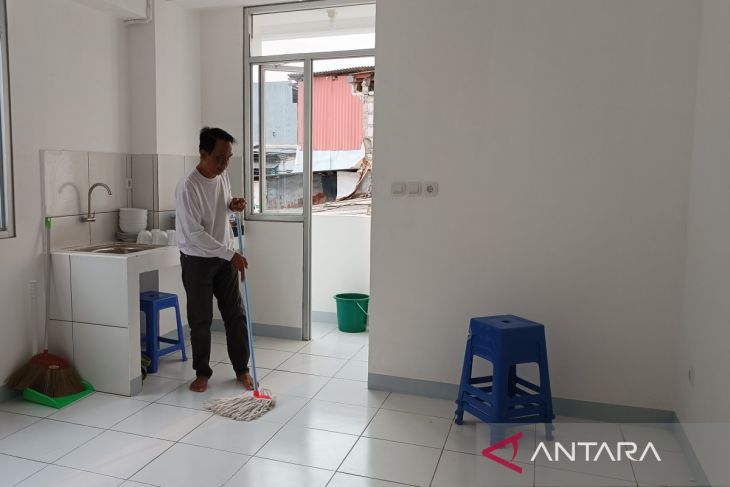A vertical transformation of Jakarta's slums

Jakarta, July 19 (ANTARA) - Sukanta's face lit up upon hearing he would get a livable house — something he never expected — even though it meant remaining in a narrow alley in one of Jakarta's dense sub-districts.
That's because, for decades, he and his family had to make do with a crude slum dwelling that lacked air circulation.
In his old house, there was no difference between day and night. Sukanta had to turn on the lights to illuminate the house even when the sun was blazing outside because sunlight is being blocked by surrounding buildings.
According to the World Health Organization (WHO), the standard area of a home must be at least eight square meters. Sukanta's was half the standard, measuring no more than four to five square meters.
It did not have any ventilation so sunlight could not enter it.
His family also did not have private sanitation and had to queue up at the public toilet to defecate.
The 63-year-old said that his old house was deteriorating due to age and was not being maintained well. He was also unable to repair its leaky roof and old walls since his income was only sufficient to buy daily food.
Now, with the help of the "Rumah Barokah Palmerah" housing program run by the government in collaboration with the private sector, his place of residence has transformed.
In the past, the area where Sukanta lived was also occupied by eight other families. Now, it has transformed into a vertical building, or a sort of a flat, under the Vertical Land Consolidation (KTV) scheme.
"This is like a dream. In the past, my house was like a shack. Now, we have a bathroom like in a hotel," Sukanta told ANTARA.
The vertical house, located in a narrow alley in the densely-populated Palmerah in West Jakarta has four floors. The lower floor can be used for public activities since there are no partitions, or as a place of opening business.
Meanwhile, the second to fourth floors serve as living quarters for nine households. Each house measures 18 square meters in area.
A livable home
The vertical housing building with its strong pillars, has captivated locals and its residents.
Kartiyo, 58, who is also a resident of the Rumah Barokah Palmerah housing, said that he was surprised by the results of his home's renovation.
He did not expect his home, which was once made of wood and plywood, to have strong concrete pillars.
Now, he can breathe fresh air inside a house that sunlight can enter. That is completely different from earlier.
Kartiyo said that before the renovation, he was always worried that water would leak into his house, especially during the rainy season. Now, with the new building, water leak is no longer a concern.
Furthermore, each vertical house unit has been equipped with adequate facilities such as a kitchen and bathroom so there is no need for its occupants to go outside to defecate.
The construction of residential buildings based on the KTV concept can be one of the solutions to redevelop Jakarta's slums without having to relocate residents to other areas.
Relocating residents to a new environment poses some challenges, for instance, residents need to adapt to the new location, which can be far from their jobs or place of business.
For this reason, the construction of vertical residential buildings to organize slum areas in Jakarta is being viewed as an appropriate fix. The Jakarta provincial government said it will build more such buildings at several points.
Acting governor of Jakarta, Heru Budi Hartono, said that the development of vertical residential buildings using the KTV model will be focused in several densely populated areas of Jakarta.
"We have selected densely populated areas. We will build similar vertical residential buildings in Cempaka Putih and Tanah Tinggi," he said.
Slum areas
As per Gubernatorial Regulation Number 90 of 2018, there are 445 neighborhoods (RW) in Jakarta that are listed as slum areas.
Slum areas are located in densely populated areas, where houses often do not have adequate lighting and air circulation due to their close proximity to each other.
Therefore, the provincial government is carrying out a gradual transformation of these areas.
The budget to redevelop slum neighborhoods has been set at Rp566 million (around US$35 thousand) per neighborhood. Besides the provincial government, the private sector is also supporting slum redevelopment through corporate social responsibility (CSR) funds.
The redevelopment of slum areas includes repairs of waterways, residential roads, lighting, and house renovations.
Jakarta legislator Khoirudin said that the redevelopment of slum areas needs to be accelerated so that the target of freeing Jakarta of slums by 2027 can be realized.
He added that the redevelopment efforts include building vertical housing in the form of rental flats and KTV-model houses.
To become a global city, Jakarta needs to improve and redevelop its densely populated and slum areas.





